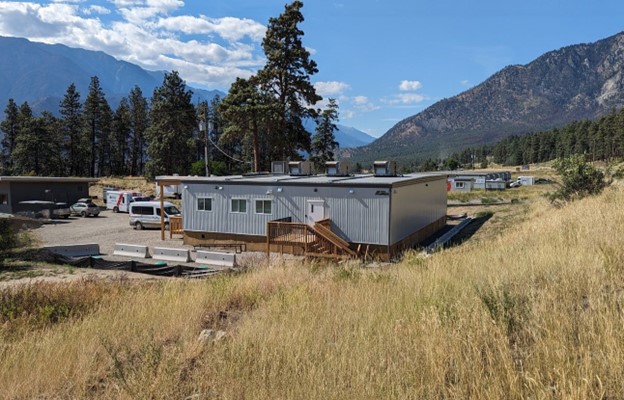Early planning work is expected to conclude this winter, but construction and sign-off from province may take years
Former residents aren’t the only people thinking about building anew in Lytton.
Two years after the village burned, and despite the grinding delays in rebuilding, local officials say they are fielding calls from outsiders or former residents interested in buying property in the community.
Meanwhile, a plan to rebuild Lytton’s health centre could be completed this fall, but it still may take another five years for the facility to actually be built and open.
In April, The Current reported on the lack of plans to return critical health services to the ravaged town. Last week, residents received new information about when a new health centre will be built in town—and when actual rebuilding work in the village may finally begin.
Before it burned in 2021, St. Bartholomew’s Health Centre provided a broad array of services to residents of the village and a wide surrounding area. And while the blaze was two years ago, health officials have only recently started considering how—and in what form—the facility will be rebuilt. Since the destruction of the village, residents have called for all the facility’s old services to be returned, while warning that delays and uncertainty are causing current and former locals to reconsider their plans to return.
Lytton residents can now access some health services nearby in a Lytton First Nations health building to the north that escaped the brunt of the blaze. A temporary modular facility with more room, more services, and improved technology is expected to be opened at the same location in the next couple months.
But the old St. Bart’s site was located in the centre of a bustling village and included many other services, including an urgent care centre, pharmacy, lab, and even assisted living housing. And most of those services remain in flux or gone.
Interior Health doesn’t have a plan yet to replace the facility, but in recent months it has finally begun work that will inform whatever is built next.
And residents have been clear about what they want to see, said Kathy Doull, the agency’s executive director for the western part of the health region.
“What we heard is a very strong desire to have the previous services returned to the levels that were available before the fire,” she told an online community meeting held last week.
Residents emphasized the need for an on-site pharmacy, a place to get lab tests taken, and a facility that can provide urgent care treatment, especially for non-life-threatening ailments like cuts, sprains and burns. Doull said that the new facility will be planned using that feedback.
“All of those things that we heard, those are the things that we’re taking into account when we’re designing and delivering services.”
But there are some new hurdles, she warned.
The old centre had six assisted-living beds for seniors. But since that facility was built just 15 years ago, the province has created new standards that don’t permit the construction of such small assisted living sites, Doull said.
That doesn’t mean assisted living is impossible, she added.
“We have to look at what is needed in the community, we have to look at what is feasible, and we have to maybe look at how we can be creative,” she said. “Maybe it’s assisted living mixed with something else so we can meet the guidelines and staffing levels that are required.”
Doull noted that residents have asked for other forms of seniors care in a new facility, including palliative care housing.
If the receptiveness of Interior Health to provideing a similar level of health service is the good news, the bad news is just how long it may take.
Doull said officials hope to have a concept and business plan ready for the Ministry of Health by this fall. Design could take place over the winter, she said, with construction beginning next summer.
But Doull said it will likely take three to five years for the facility to actually be constructed. And that timeline is itself uncertain—and only partially in the hands of Interior Health: Doull noted that provincial officials must sign off on theh project before any ground is broken.
The track record of Lytton’s rebuilding so far, and the various factors that have slowed it down—from archeology work to bureaucracy to weather events—provide reason for skepticism.
Still, some clarity seems to be coming.
When asked by Tricia Thorpe, an elected representative for rural residents in the area, about when residents will know enough about the future health centre to start making plans for their lives, Doull said: “that should be coming quite soon. By the end of this year, we should have defined what that future state looks like so hopefully that question will be answered and people will be able to make firm decisions.”





